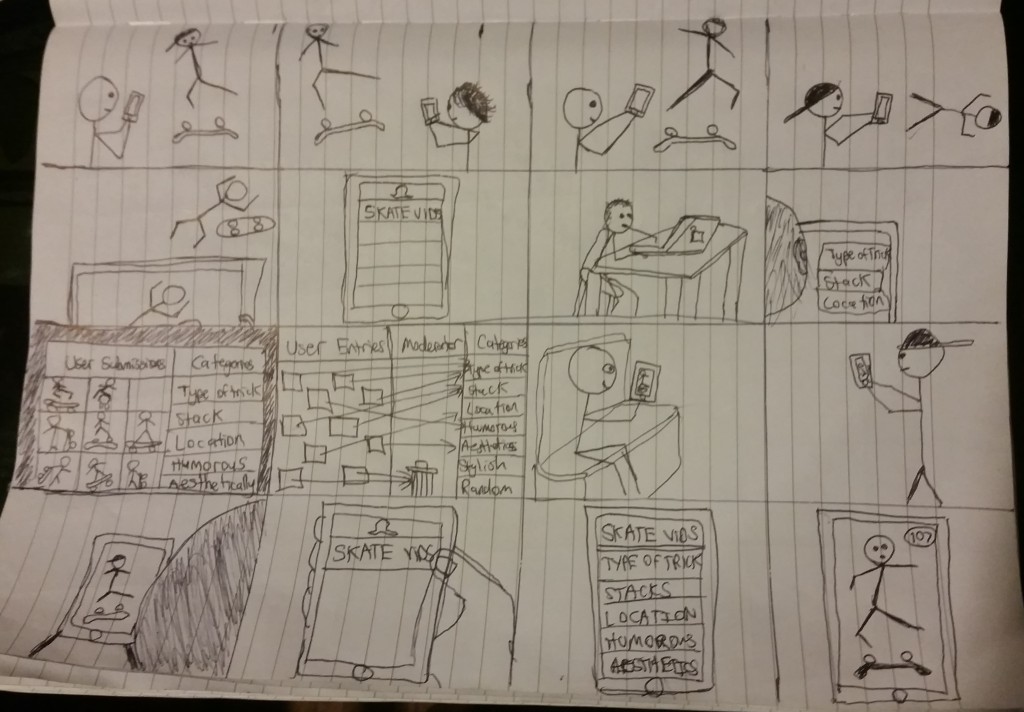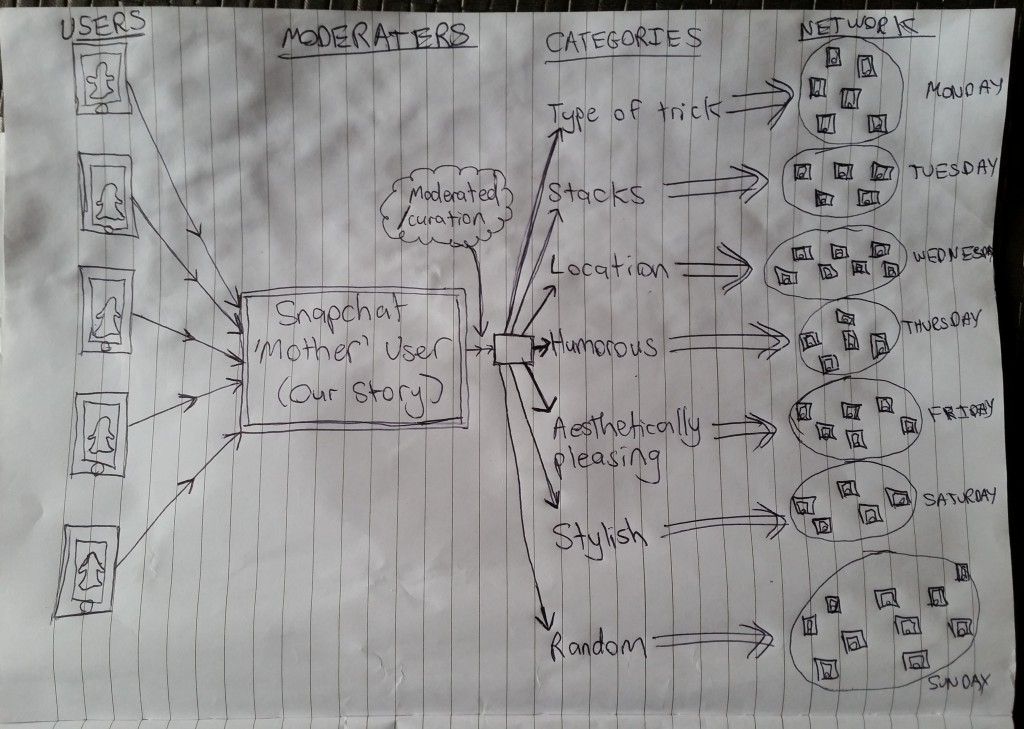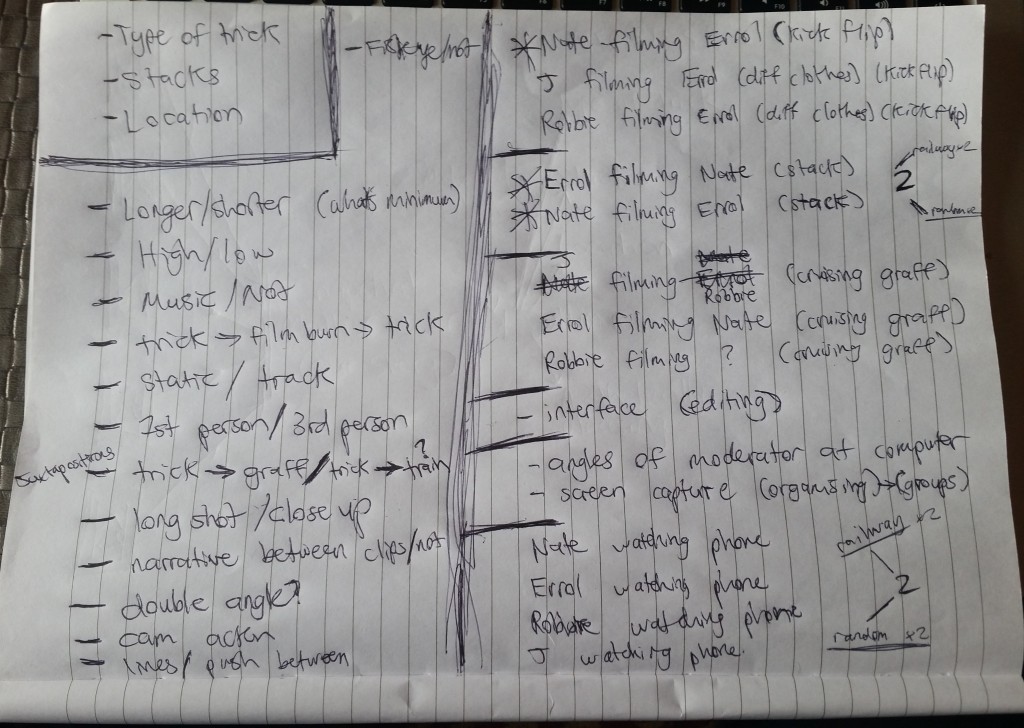Online Video Experiments is a class that is part of the Bachelor of Communication (Media)’s new studio model. As opposed to traditional theory-led tutorials, the studio concept and in particular Online Video Experiments, is balanced with practice-led inquiries. This style of learning entailed an approach to media analysis that was completely new to me and I decided to apply myself through the use of the Media Factory blog in order to engage with Online Video Experiments and the concepts presented. These notions are indicated in my first blog entry ‘Practice Based Learning (Week 1)‘. Analysis of the development of my blog can be used to demonstrate how my practice has changed over the course of the semester in Online Video Experiments, as well as highlight what I have learnt in regards to the way I conduct myself as a media professional. Firstly, Online Video Experiments has encouraged me to brainstorm through the use of mind maps and drawings. However, I have learnt not to get too caught up in the brainstorming process. Also, the encouragement to conduct speculative sketching has changed how I approach creative practice. While most prominently, I have learnt the importance of focussing on form over content in relation to analysis of media. Finally, the combination of these literacies has widened my perspective of creative practice toward a more innovative and experimental approach.
Visual Brainstorming
The initial weeks of the Online Video Experiments studio brought for me, an introduction to using both handwritten and digital mind maps as a process of brainstorm. As seen in my blog post ‘Mind Mapping (Week 2)’, we used this technique to break down the concept of ‘online video’ into individual components and associated terms, in order to understand the concept from an array of perspectives. My continued use of visual brainstorming is evident in the way I approached later explorations over the course of the studio (see ‘Project Two Progress (Week 3) Mind Map’), but also influenced the way I began to create lists, diagrams and drawings to visually dissect and explore ideas (see ‘Project 4 Progress (Week 11) Shot List’ and ‘Project 4 Progress (Week 11) Diagram’ and ‘Project 4 Progress (Week 11) Storyboard’). Before Online Video Experiments, in the initial stages of a project I would tend to jump ahead and immediately create material, without firstly grounding my understanding of terms and forming a structure for the exploration. Visual brainstorming is useful because it spawns innovative ideas and associations that may not have surfaced otherwise, but also prevents going off track. Proof of this is evident in the development of my group’s project 3. One particular blog post ‘Project 3 Progress ‘From Case Study to Probe’ (Week 6)’, demonstrates a more recent example of how visual brainstorming has prompted the creation of an otherwise difficult to articulate, innovative path of discovery. Whilst the text in the blog post may be hard to follow, the visual map below clarifies the process. The Online Video Experiments studio has thus taught me the importance of preparation and altered the way I conduct myself as a media professional in the way I approach the initial stages of a project; with a strong inclination toward visual brainstorming.
Improvisation
As much as the brainstorming process is clearly useful, I have also learnt during this studio to avoid fixation on the planning process. It is natural to get caught up by perfectionist planning, continuously improving an idea in theory. When actually its experimentation and practice-led enquires into underdeveloped ideas, that can potentially prompt innovative discoveries and encounters that may completely redirect the pathway of exploration. For example, my blog post ‘Caught Up In The Planning Process (Week 5) w/ the 4 R’s’ , demonstrates how upon reflection of project 2, I noticed my group’s fixation on the quality of initial ideas and as a result we spent “too much time caught up in the brainstorming and planning process” (quote from blog post). During this studio, whilst brainstorming is definitely encouraged, there has been a big emphasis on moving beyond the brainstorming phase quickly to “unpack an idea by making stuff” (Seth Keen – Studio 16/03/2015). Some of my more recent blog posts indicate how my practice has changed from being fixated on brainstorming, to instead “go crazy making stuff… …and see what discovery we can make” (quote from blog post ‘Dictching Live Broadcast (Week 8)’). Moreover, even more recent blog posts exhibit how this technique has been implemented into project 4, so that we could “start making stuff as soon as possible in the hope that visual, rather than conceptual reflection would move the project along” (quote from blog post ‘Monday 11th May Studio (Week 10)’). Furthermore, these notions also form the basis of our rapid prototyping, in which a less prepared approach to experimentation was crucial to our understanding of how ‘skate video’ might function in Snapchat (see blog post ‘Project 4 Progress (Week 11) Rapid Prototyping’). In contrast to projects 1, 2 and 3, noticing the smooth development and relevance of project 4 in regards to the studio prompt, clearly highlights the way this process of unpacking an idea through making, was useful as it kept the process simple and more direct. This contrast between the projects, in combination with the development of my blog demonstrates how my practice has altered toward a balance of brainstorming and improvised experimentation.
Speculative / Innovative Sketching
These improvised experiments were mainly in the form of sketches. As evident in the blog post ‘Sketch vs Prototype (Week 3)’, this studio distinguished the difference between sketches and prototypes, positioning sketches as disposable content at the initial stages of a project. The Online Video Experiments studio encouraged students to conduct speculative sketching, which has altered my approach toward creative practice. Before this studio, in an impatient attempt to make a start, I was inclined to quickly generate and accept one of the first plausible ideas for a project. However, over the course of this studio I have learnt the importance of continuously improving ideas. Within academic and social institutions, a process called satisficing forms the basis of problem solving. Satisficing is referred to by psychologists as “accepting the first plausible solution to a problem” (Eric Booth 2012). This process “completely eliminates the possibility of significant creative accomplishment” (Eric Booth 2012). The blog post ‘Friday 10th April Studio (Week 5) Innovative Sketching’, shows how my understanding of speculative/innovative sketching developed and highlights that “I am excited to go crazy making as many skecthes as possible and just see what happens” (quote from blog post). The way my practice has altered toward notions of speculative sketching can be seen through the development of project 3 throughout blog posts ‘Speculative Sketching ‘Three Things of Interest’ (Week 6)’ and ‘Speculative Sketching ‘One Interest’ (Week 6)’ and ‘Speculative Sketching ‘Probe’ (Week 6)’ and ‘Speculative Sketching ‘Final Probe’ (Week 7)’. Analysis of these blog posts demonstrate how speculative sketching has been used to transform three potential ideas, through a process of constant redevelopment, into a final innovative concept.Therefore, the way I conduct myself as a media practitioner has altered toward a “process of constant improvement and reflection which will produce an innovative idea, something much stronger and more advanced than the first original notion. i.e. take something from online video and push it sideways and play with it” (quote from blog post ‘Monday 13th April Studio (Week 6)’).
Form Over Content
In addition to speculative sketching, I have learnt the importance of focusing on form over content in relation to analysis of media. Throughout the course of this studio, a recurring issue I am confronted with, is becoming blindly fixated on stylistic techniques, as opposed to narrative/non-narrative form. The latter being the primary focus of the studio is therefore integral. The early blog post ‘Project Two Progress + Reworked Concept Statement (Week 4)’, lists 10 initial sketch ideas that deconstruct ‘skate video’ as an example of online video practice. The vast majority of the list focuses on stylistic techniques as opposed to form. I recognised this issue, as evident in the blog post ‘Studio Issue Reflection (Week 4) Using The 4 R’s’, which uses the ‘4 R’s’ method of reflection, attained from this studio, to dissect the issue. Whilst the ‘4 R’s’ process itself is an example of how my practice has changed in regards to reflection over the course of this studio, that blog post also relates my fixation on stylistic techniques to my experience in practical video production. Furthermore, a slightly more recent blog post further demonstrates how this issue was again encountered, but solved to alter my practice toward notions of form. “This shifted the focus of our presentation away from plainly addressing notions of content… …to new sketches that address the form itself, rather than becoming caught up on stylistic techniques that may not contribute toward a narrative/non-narrative” (quote from blog post ‘Friday 27th March Studio (Week 4) Form over Content’). This alteration in how I approach form over content is anchored to my understanding of form, which developed over the course of this studio. This is evident in the blog post ‘The Concept of Form (Week 6)’ in reference to Bordwell and Thompson. Final evidence of how my practice has changed in this way can be seen in a blog post toward the end of the semester, ‘Monday 18th May Studio (Week 11)’. This blog post demonstrates how the exploration of project 4 has finally become anchored to notions of form in relation to Snapchat and our innovative, collaborative service.
Evolving Industry
Finally, the combination of all the aforementioned literacies has widened my perspective of creative practice toward a more innovative and open-minded approach, which has also re-established my confidence in higher education study. In many instances throughout this degree, I have found myself reflecting upon the higher education module in question of whether the theoretical detail is necessary for my intended career as a videographer. For example, a blog post from last year in Networked Media ‘Did someone say jump ship?’, highlights my questioning of the relevance of this course as opposed to something more formula or technical based. However the Online Video Experiments studio regained my focus on theoretical interrogation and experimentation of new media, as opposed to seeking practical skills for current media. This is highlighted by the blog post ‘Friday 17th April Studio (Week 6)’, which shows a ‘light-bulb moment’ occurring as I realise the importance of the higher education process as it “encourages us to create something new and different that is innovative in regards to where online video is heading or evolving” (quote from blog post). Therefore, Online Video Experiments has had a large impact on the way I conduct myself as a media professional as it has realigned my focus toward innovative practices.
Online Video Experiments has been embraced as a new style of learning in this degree as a balance between theory-led and practice-led inquiries. Through analysis of the development of my contributions to the Media Factory blog, it is clearly evident the way Online Video Experiments has altered the way I conduct myself as a media professional. It has become clear that the emphasis on visual brainstorming in Online Video Experiments has improved my preparation in regards to potential projects. Also just as important, I have learnt to avoid fixation on brainstorming and to instead improvise. Moreover, I have discovered the process of speculative sketching and noticed the way it generates innovative ideas. Furthermore, I now value form over content in relation to analysis of media. Finally, the combination of these developments and the Online Video Experiments studio in general, has transformed my creative practice toward notions of innovation.


